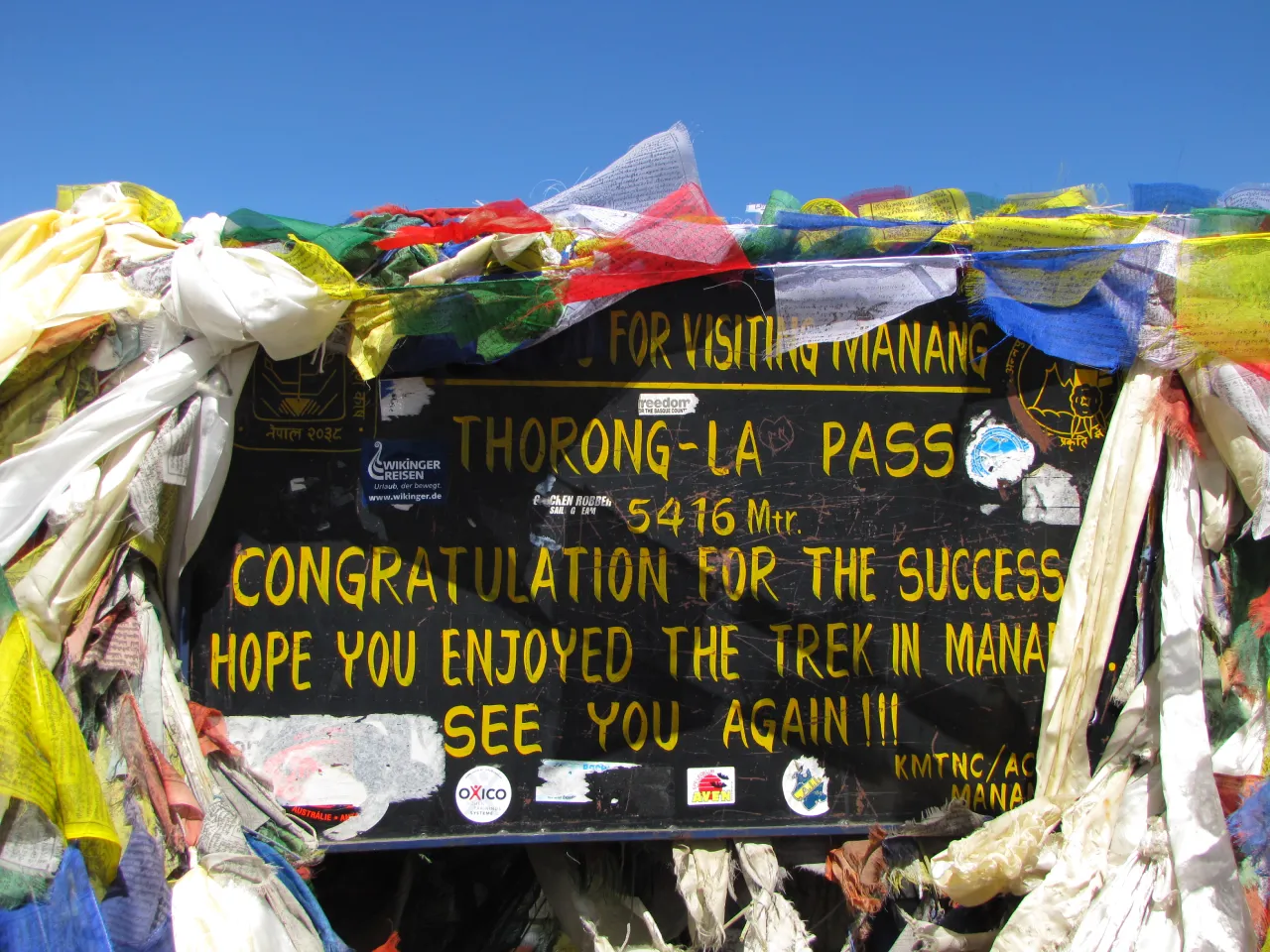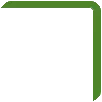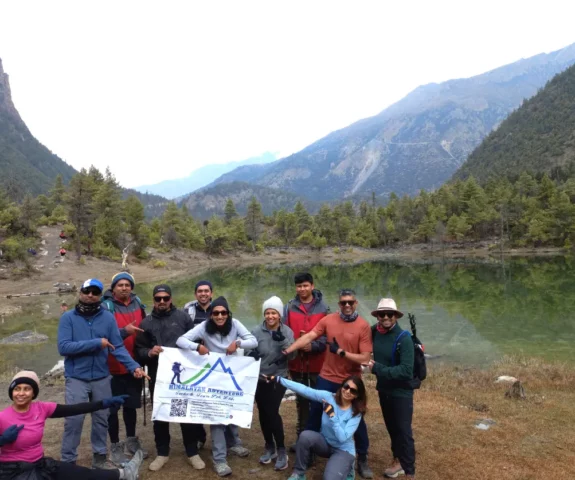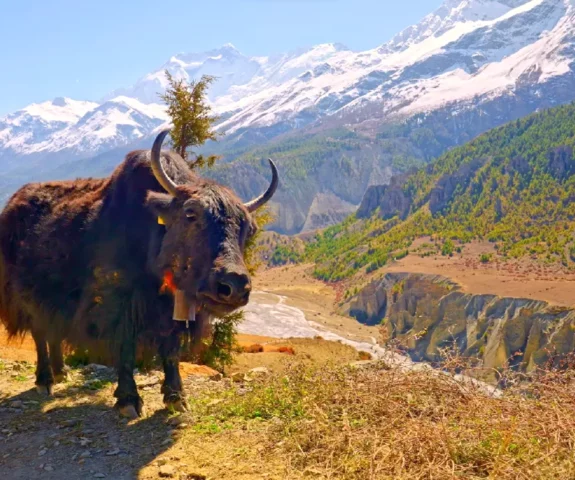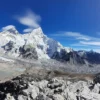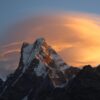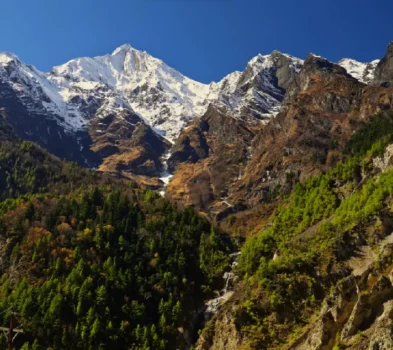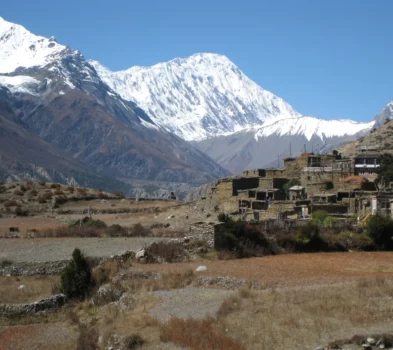Duration
13 DaysAnnapurna Semi Circuit Trek
Trip Grade
ModerateGroup Size
1-16 PeopleMax Altitude
5,416m. / 17,769ft.Best Season
Feb- May/ Sept- NovActivity
Trekkling & HikingMeals
Breakfast, Lunch & DinnerAccommodation
Hotels & TeahousesTransportation
Private Vehicle & BusTrip Customization
On request (click here)Highlights of Annapurna Semi Circuit Trek
- Cross the Marsyangdi River on a 150-meter suspension bridge near Tal village.
- See the 14th-century Buddhist murals inside Braga Monastery in Manang.
- Walk through Tilicho Base Camp’s glacial valley below 7134m Tilicho Peak.
- Feel the 1566-meter altitude drop from Thorong La Pass (5416m) to Muktinath (3850m).
- Touch the 200-year-old mani walls carved with “Om Mani Padme Hum” near Pisang.
Trip Introduction
The Annapurna Semi Circuit Trek takes you through Nepal’s Annapurna Circuit where you walk approximately 160 kilometers around the Annapurna massif. You start in Kathmandu at 1400 meters and reach the peak elevation of Thorong La Pass at 5416 meters. We pass through eight distinct climate zones from subtropical forests to arid high deserts. The trail follows the Marsyangdi River valley and crosses the Thorong La into the Kali Gandaki valley. En route, you meet Gurung and Tamang communities in the lower regions and Tibetan Buddhist Manangis higher up in the valley.
Manang village has 2000 residents who speak the endangered Manangi language and grow buckwheat for tsampa. You can see their ancient monasteries in villages like Braga with 500 to 600-year-old murals and Tilicho Lake near Manang at 4919 meters. The Conservation Area spans 7629 square kilometers and the community-based Annapurna Conservation Area Project (ACAP) was launched in 1986. To enter this protected region, you need two permits: ACAP at 3000 NPR and TIMS at 2000 NPR.
October and November see 200 trekkers daily on this route according to Nepal Tourism Board data. You eat dal bhat and drink butter tea in basic teahouses built by local families. German explorers first completed this circuit in 1956 and documented its trade routes. Following the route, we cross suspension bridges over raging rivers and walk past mani walls carved with Buddhist prayers. We run this trek only in the dry seasons because monsoon landslides block trails from June to September.
We handle your permits before you land in Kathmandu. We submit your ACAP and TIMS applications days before the starting date. Our team will book teahouses along the entire route including Manang and Thorong Phedi. We will assign guides with years of Annapurna experience who speak fluent English. They monitor your oxygen saturation daily above 3000 meters. Our team checks weather alerts hourly during trekking season and the guide carries a satellite phone above 4000 meters for medical emergencies. You get immediate evacuation support if needed. We pre-pay all teahouse meals so you carry less cash. Himalayan Adventure Trek simplifies logistics so you experience the mountains not the paperwork.
Outline Itinerary of Annapurna Semi Circuit Trek
Day 01: Arrival at Kathmandu Airport
Day 02: Drive from Kathmandu to Besisahar
Day 03: Drive from Besisahar to Dharapani
Day 04: Trek from Dharapani to Chame
Day 05: Trek from Chame to Pisang
Day 06: Trek from Pisang to Manang
Day 07: Rest day at Manang and walk to Gangapurna Glacier Lake
Day 08: Trek from Manang to Yak Kharka
Day 09: Trek from Yak Kharka to Thorong Phedi
Day 10: Trek from Thorong Phedi to Muktinath via Thorong La Pass
Day 11: Drive from Muktinath to Pokhara
Day 12: Drive from Pokhara to Kathmandu
Day 13: Departure from Kathmandu Airport
Our guests sharing their experiences (Photo/Video Gallery)
Detail itinerary of Annapurna Semi Circuit Trek
Day 01: Arrival at Kathmandu Airport
On the first day of the Annapurna Semi Circuit Trek, we arrive at Tribhuvan International Airport in Kathmandu around midday. No trekking happens today, you just clear immigration, collect your bags, and meet our representative outside the terminal. A private transfer waits for you; thus ride to the hotel for the night takes 30 minutes. Motorcycles weave through gaps as the roads are quite busy in Kathmandu.
Your hotel room is simple and clean. Air conditioning hums softly as you enter the room and prepare to rest. You should check your gear and see if you have anything missing. We confirm tomorrow’s early departure, the guide will give you the details. Altitude gain.
We eat a light meal at the hotel, most likely Dal bhat and tea, before heading to bed. Tomorrow we drive six hours to Besisahar, so we need to rest. We recommend trekkers pack their daypack with sunscreen, a hat, a water bottle, and snacks. We leave our unnecessary heavy packs at the hotel.
Activity: Airport Pickup, 30 min
Max. Altitude: 1,400m/4,593ft. Kathmandu
Accommodation: Hotel
Day 02: Drive from Kathmandu to Besisahar
Day 2 of the Annapurna Semi Circuit Trek takes you from Kathmandu to Besisahar by road. You leave early, usually before dawn, to avoid traffic. The drive covers about 170 kilometers and lasts six to seven hours. Roads are narrow and winding, with trucks, buses, and livestock sharing the route. You pass through terraced hillsides, small villages, and rivers cutting through deep gorges. The terrain shifts from the flat Kathmandu Valley to the rising foothills of the Himalayas.
As you climb, the air cools, and the greenery thickens. Rice fields give way to maize and millet after we cross the Trishuli River on a sturdy bridge. The river churns white with meltwater, a distinct view for most. The bus stops for lunch in Mugling, a busy junction where the Prithvi Highway meets the road to Pokhara. You arrive in Besisahar as the sun drops behind the hills. The town sits at the edge of the Annapurna region. It is the last real town before the trail begins.
Activity: Drive, 6-7 hours
Max. Altitude: 823m/2,700ft. Besisahar
Meal: Breakfast, Lunch & Dinner
Accommodation: Teahouse
Day 03: Drive from Besisahar to Dharapani
The following day of the Annapurna Semi Circuit Trek takes you from Besisahar to Dharapani, a 16-kilometer drive that lasts about two to three hours. You start on a wide road, but soon leave it behind for narrow trails climbing steadily through terraced fields and small villages. The path winds past waterfalls, bamboo groves, and stone houses with red-tiled roofs. You cross the Marshyangdi River twice on suspension bridges; one is long and sways slightly underfoot. The trail gains 1000 meters in elevation, mostly steadily, with no steep scrambles. You pass through Chaurikharka and Bahundanda, where locals sell boiled eggs and tea from open-air stalls.
The air cools as you rise above the valley floor. By late afternoon, you reach Dharapani, a quiet village with basic teahouses and views of snow peaks to the north. Most trekkers rest here after a full day of walking. The trail is well marked, often crowded with porters and other hikers. No technical gear is needed, just wear good boots and carry enough water. The descent into the river gorge early in the day feels long and the final climb out feels harder. But Dharapani welcomes you with warmth, hot meals, and quiet nights.
Activity: Drive, 4-5 hours
Max. Altitude: 1,860m/6,102ft. Dharapani
Meal: Breakfast, Lunch & Dinner
Accommodation: Teahouse
Day 04: Trek from Dharapani to Chame
The 4th day of the Annapurna Semi Circuit Trek starts at Dharapani at 1860 meters. You hike 13 kilometers to Chame at 2675 meters. The trail climbs steadily through rhododendron forests and rocky switchbacks. We cross the Marsyangdi River on a suspension bridge near Koto. After that, the path narrows and hugs the mountainside with steep drop-offs. The air grows thinner as we go up and pass small villages where stone houses and prayer flags mark the route. A few teahouses offer tea and dal bhat.
Most trekkers take six to seven hours to complete this trek, featuring an elevation gain of about 815 meters. No major descent is en route. The climb tests your lungs but rewards you with views of Annapurna South and Hiunchuli. You enter Manang District at Chame, the town sits in a wide valley and has more amenities than earlier stops.
Hot showers are available and internet connectivity is also provided. You will sleep here at 2675 meters and build endurance for higher altitudes ahead. The trail is well marked and our local guides know the route like the back of their hands. Follow their pace and don’t shy away from resting when tired.
Activity: Trek, 5-6 hours
Max. Altitude: 2,675m/8,776ft. Chame
Meal: Breakfast, Lunch & Dinner
Accommodation: Teahouse
Day 05: Trek from Chame to Pisang
On day 5 of the Annapurna Semi Circuit Trek, you leave Chame at sunrise. The trail climbs steadily through dense rhododendron forests where snow-capped peaks appear between the trees. You cross a wooden bridge over the Marsyangdi River from where the path widens into a gentle ridge. You pass small stone prayer wheels and mani walls carved with Buddhist mantras. We then enter a quieter valley. The village of Pisang appears below you, its rooftops lined with dried corn and barley.
The trek takes about six hours and you cover about 14 to 16 kilometers. You gain 650 meters in elevation and there are no steep drops or technical sections. The trail is well marked with red and white flags while the locals sell basic food and tea at small stalls.
You stop for lunch near a chorten. After lunch, the wind picks up as you approach Pisang. The village sits on a high terrace, featuring stone houses with turquoise windows. A monastery overlooks the valley, and the view of Annapurna II and Ngadi Himal becomes clear by afternoon.
Activity: Trek, 5-6 hours
Max. Altitude: 3,100m/10,171ft. Pisang
Meal: Breakfast, Lunch & Dinner
Accommodation: Teahouse
Day 06: Trek from Pisang to Manang
The trail covers about 12 kilometers and takes five to six hours to complete on average. You start at 3100 meters and climb steadily to 3540 meters. The elevation gain of day 6 of the Annapurna Semi Circuit Trek is 440 meters. You leave Pisang’s stone houses and enter a narrow valley as the path winds beside the Marsyangdi River, then climbs away from it. You pass through high-altitude scrubland, and the trees thin out as we gain elevation.
You then cross two small suspension bridges over rocky streams. The trail turns rocky and steep in places. You see prayer flags fluttering on ridges. Herdsmen with yaks pass the route we trek, with their bells ringing in the wind. You stop for tea at a teahouse near Ngawal.
There, the view opens up, including Gangapurna, Annapurna II, III, IV, and other peaks that loom ahead. You reach Manang just before afternoon, and stone and wood houses line the street where shops sell dried meat and wool blankets.
Activity: Trek, 6-7 hours
Max. Altitude: 3,440m/11,286ft. Manang
Meal: Breakfast, Lunch & Dinner
Accommodation: Teahouse
Day 07: Rest day at Manang and walk to Gangapurna Glacier Lake
Day 7 of the Annapurna Semi Circuit Trek is a rest day designed for acclimatization. You start in Manang at 3540 meters and hike to Gangapurna Glacier Lake at 3440 meters. The trail is gentle and steady. You walk for about 1 hour, covering a distance of roughly 3 kilometers round-trip. The elevation loss is minimal, just 100 meters, but the thin air makes every step count.
You leave Manang on a wide, well-trodden path. The trail climbs slowly through scattered juniper trees. The sky clears as you move higher, and soon enough, you see Gangapurna’s icy face ahead, a wall of blue-white ice framed by rock. The lake sits at the base of the glacier and the water is turquoise from glacial silt. Ice chunks float like shattered glass, and silence fills the valley.
Activity: Explore Manang, 3-4 hours
Max. Altitude: 3,440m/11,286ft. Manang
Meal: Breakfast, Lunch & Dinner
Accommodation: Teahouse
Day 08: Trek from Manang to Yak Kharka
Leaving Manang, the trail climbs steadily through rocky slopes and sparse alpine scrub. We walk about 10 kilometers over 5 to 6 hours. By the end of the trek, the elevation rises from 3540 meters to 4050 meters. Just a steady ascent with no technical passages. The path winds past small stone walls and prayer flags fluttering in thin air. Animals graze on hardy grasses as the ground turns rocky. The wind picks up and you can feel the altitude.
You reach Yak Kharka as shadows stretch long across the valley. The village has a few teahouses, stone houses with low ceilings, and chortens. The warmth inside the teahouses comes from wood stoves. You see no trees nearby, only dust, rock, and sky. This is high Nepal, there are no rivers here, not much greenery, just silence and space. Tonight you sleep at 4050 meters above sea level.
Activity: Trek, 4-5 hours
Max. Altitude: 4,050m/13,287ft. Yak Kharka
Meal: Breakfast, Lunch & Dinner
Accommodation: Teahouse
Day 09: Trek from Yak Kharka to Thorong Phedi
The next day on the Annapurna Semi Circuit Trek, we have to walk 6 kilometers to Thorong Phedi, reaching 4450 meters. The trail climbs steadily over 5 to 6 hours, traversing rocky and narrow trails with no trees. We pass small prayer flags nailed to wooden poles. The air keeps getting thinner with every step. Soon enough, breathing becomes deliberate, you have to take longer breaths to get enough oxygen in your system. Altitude sickness waits for anyone who rushes.
The trail rises through scree slopes while loose gravel shifts under boots. If you notice, no one talks much on this part of the trail, as they focus gravely on the trail. Thorong Phedi is a cluster of stone lodges, you are highly unlikely to get hot showers there. Just warm tea and sleeping bags are what you need to spend he night. We sleep here at 4450 meters and tomorrow, we climb Thorong La Pass, reaching 5416 meters above sea level. This is the final night before the highest point.
Activity: Trek, 3-4 hours
Max. Altitude: 4,450m/14,600ft. Thorong Phedi
Meal: Breakfast, Lunch & Dinner
Accommodation: Teahouse
Day 10: Trek from Thorong Phedi to Muktinath via Thorong La Pass
This day on the Annapurna Semi Circuit Trek begins before dawn at Thorong Phedi. You start climbing on a narrow, rocky trail that switchbacks up the ridge toward Thorong La Pass. The air is thin and each step demands focus.
The sun rises over the Annapurna range as you reach 5000 meters. The wind bites your skin and snow dusts the path as you pass prayer flags frozen in place. At 5416 meters, the pass opens to a vast, silent plateau, a scene you will remember for years. You stand above the clouds while distant peaks like Annapurna I and Dhaulagiri dominate the horizon.
The descent begins immediately and the trail drops sharply over loose scree and ice patches. You lose 1500 meters in elevation and by midday, you reach Muktinath at 3850 meters. The total walk takes six to eight hours and the distance is about 15 to 18 kilometers. Few trekkers complete this without breathlessness. Oxygen levels are 50 percent lower than at sea level.
Activity: Trek, 8-9 hours
Max. Altitude: 3,850m/12,631ft. Muktinath
Meal: Breakfast, Lunch & Dinner
Accommodation: Teahouse
Day 11: Drive from Muktinath to Pokhara
The following day on the Annapurna Semi Circuit Trek itinerary, we drive down to Pokhara, 822 meters above sea level. The journey covers 195 kilometers and takes 9 to 10 hours. The road winds through the Kali Gandaki River valley and you pass through Jomsom, Tukuche, and Tatopani. The descent is steady, your ears pop as altitude drops. The landscape shifts from high desert to green terraces and villages grow denser.
Stone houses give way to wooden homes with tin roofs. You see farmers tending maize and wheat, rivers swell with glacial melt. Buses and jeeps share the narrow road as dust hangs in the air. Some travelers nap while most stare out the window. The scenery changes every hour or so, and we cross multiple bridges over roaring rivers.
Activity: Drive, 6-7 hours
Max. Altitude: 822m/2,697ft. Pokhara
Meal: Breakfast & Lunch
Accommodation: Hotel
Day 12: Drive from Pokhara to Kathmandu
The trekking days of the Annapurna Semi Circuit Trek are gone, what remains are just drives. Today, you drive from Pokhara to Kathmandu, the route follows the Prithvi Highway, a well-maintained national road that cuts through Nepal’s mid-hills. We leave Pokhara at eight in the morning, and the drive covers 200 kilometers. It takes seven to eight hours to drive from Pokhara to Kathmandu. You pass through scenic valleys and terraced farms, cross rivers like the Seti and Kali Gandaki.
You climb from 822 meters in Pokhara to 1400 meters in Kathmandu. The ascent is very gradual; no hiking is needed, and no altitude gain needs to be managed. You just sit in a private vehicle or shared tourist bus. Windows roll down for fresh air, but dust flies when trucks pass, so keep your hand ready to close the windows.
Activity: Drive, 6-7 hours
Max. Altitude: 1,400m/4,593ft. Kathmandu
Meal: Breakfast & Dinner
Accommodation: Hotel
Day 13: Departure from Kathmandu Airport
This is the final day of the Annapurna Semi Circuit Trek, you leave Kathmandu after you pack your gear one final time. We will have you check out of your hotel after breakfast, and drop you off at the airport. Your driver waits outside with the door open. You ride to Tribhuvan International Airport in silence as you reminisce about the memories you made on the trek.
Activity: Airport drop, 30 min
Max. Altitude: 1,400m/4,593ft. Kathmandu Airport
Meal: Breakfast
Note:
If you have your own private group and want to make your trip private, we can run the custom trip all the day as per your requirements and group size.
Includes and Excludes
What are included with package?
- Airport Pickup & Transfer: Private vehicle service for pick-up from the airport and transfer to your hotel.
- Hotel Stay in Kathmandu: Enjoy three nights in a comfortable 3-star hotel in Kathmandu with breakfast included.
- Hotel Stay in Pokhara: Stay one night in a 3-star hotel in Pokhara with breakfast provided.
- Meals During Trekking: All meals (lunch, dinner, and breakfast) are included during the trek.
- Flight from Jomsom to Pokhara: The flight ticket from Jomsom to Pokhara is included.
- Kathmandu Sightseeing: Explore Kathmandu’s attractions with a private vehicle and an experienced tour guide.
- Bus Transportation: Travel from Kathmandu to Besisahar and from Pokhara to Kathmandu by bus.
- Necessary Paperwork: All required paperwork for the trek, including permits, is handled.
- Accommodation During Trek: All accommodations in teahouses and lodges during the trek are arranged.
- Trekking Permit (ACAP): The Annapurna Conservation Area Permit (ACAP) is included.
- TIMS Permit: The Trekkers’ Information Management System (TIMS) permit is also provided.
- Trekking Staff: An experienced, friendly trekking guide and porters (one porter for every two clients) will accompany you.
- Medical Supplies: A first aid kit is provided for any medical emergencies during the trek.
- Government Taxes: All government taxes related to the trek and services are covered.
- Farewell Dinner: Enjoy a special farewell dinner at an authentic Nepalese restaurant with a cultural performance on the last night.
What are not included with package?
- Nepal Visa Fee: The Nepal visa fee is not included, but it can be easily obtained upon arrival at Kathmandu Airport.
- Entrance Fees in Kathmandu & Pokhara: Entrance fees for attractions in Kathmandu and Pokhara are not covered in the package.
- International Airfare: International flights to and from Kathmandu are not included.
- Extra Night Accommodation: Any extra hotel accommodation due to early arrival, late departure, or an early return from the trek (for any reason) will be at the traveler’s expense.
- Meals in Kathmandu & Pokhara: Meals in Kathmandu and Pokhara, including any extra meals due to early return from the trek, are not included.
- Travel and Rescue Insurance: Travelers are required to have their own travel and rescue insurance, which is not included.
- Personal Expenses: Costs for personal items such as phone calls, laundry, bar bills, battery charging, extra porters, bottled or boiled water, and hot showers are not covered.
Pick Your Suitable Date
Book a Private Trip
Private & Group Discount Price
-
1 -
1 person
US$ 1400
-
2 -
2 people
US$ 1000
-
3 -
5 people
US$ 850
-
6 -
10 people
US$ 750
-
11 + people
9999
US$ 650
Total Cost:
US$ 1400
Route Map & Altitude Chart
Kathmandu
Start/End point
Kathmandu
Trip Information
Add-Ons
Upgrade Your Accommodation in Kathmandu
We offer the option to upgrade your stay in Kathmandu because comfort matters after the Annapurna Semi Circuit Trek. You arrive tired and heavily exhausted. We can book you into a 4 or 5-star hotel with luxury rooms and reliable hot water. We choose properties with quiet rooms and blackout curtains so you can sleep deeply. Compared to the trekking days on the Annapurna Semi Circuit Trek, you get a proper bed with thick mattresses. Not a thin mattress on a wooden frame. Not shared bathrooms down the hall and you shower without waiting for solar-heated water to kick in.
We pick hotels near Thamel but not inside its busiest lanes. You stay close to gear shops, cafes, and pharmacies. You walk to dinner at nearby eateries with tasty specialties or just enjoy the delicacies at your hotel or resort. Breakfast is usually complimentary at luxury accommodations, which include eggs, toast, sandwiches, fresh fruit, etc,., with tea, juice, coffee, and other drinks. You drink coffee that isn’t instant, unlike in the highlands. You sit outside if the weather holds, enjoying the scenes of the hills.
You do not have to waste time hunting for taxis. We arrange airport pickup and drop-off and also transfers to your upgraded accommodation. You move from trek to hotel to flight without stress.
Kathmandu Sightseeing Before Starting the Trek
We can also include Kathmandu sightseeing before the Annapurna Semi Circuit Trek. You have to arrive early for this, so that we can use that day to go around the town. We will show you the cultural side of Kathmandu, visiting many historic sites within the valley. Kathmandu holds seven UNESCO World Heritage Sites in total, and we will visit three key ones.
The first thing in the morning, we walk through Swayambhunath, the Monkey Temple. It sits on a hill west of the city and you have to climb 365 steps. You see the white dome, the golden spire, and the all-seeing eyes of Buddha. Monks chant hymns and prayers in the wee hours and you can go around the monastery, spinning the prayer wheels.
Following that, we drive to Pashupatinath Temple, a sacred Hindu cremation site on the Bagmati River. Priests burn bodies in open-air pyres, following the ancient ritual of Vedic traditions. We observe from a distance and respect the sanctity. Leaving the shores of Bagmati, we explore the Boudhanath Stupa, one of the largest stupas in the world. Pilgrims circle clockwise and so do we, spinning the prayer wheels.
We eat dal bhat near Thamel, drink some sweet tea, juices, or local drinks. We review your gear list and check our permits, before moving on to our next destination.
Private Helicopter flight from Jomsom to Pokhara
We offer an upgrade to a private helicopter flight between Jomsom and Pokhara as an add-on. You use this option to save time or avoid risky weather delays on the Annapurna Semi Circuit Trek. The flight from Jomsom to Pokhara takes about twenty minutes. You depart from Jomsom Airport’s domestic terminal and you land at Pokhara International Airport, which sits at 824 meters above sea level.
A private charter costs USD ______ for the entire helicopter. It carries up to five people. This means your cost drops if you share with others. Shared seats range from USD ______ to _____ per person. We book daily flights through licensed operators.
You fly over terraced hills, deep valleys, and Himalayan peaks. You see the Annapurna Himalaya Range and the Dhaulagiri Himalaya Range during clear weather. It is very important to keep your seatbelt fastened the whole time. For those who want to know, you can not change seats mid-flight. We expect you to follow all pilot instructions without exception. We recommend this for trekkers with tight schedules or those returning after a long expedition.
You skip the crowded airport queues and avoid overnight waits due to flight cancellations. You start your trek on your terms. We confirm your slot 48 hours before departure, while you must provide your weight and passport details for flight planning. We will send a coordinator to assist at the helipad. You receive a safety briefing before boarding and we recommend you carry one soft-sided bag up to 10 kg. We track the weather closely to secure a safe window. This way, you gain control over your itinerary, while we make it seamless.
Pokhara Sightseeing Before Your Return to Kathmandu
We can even extend your Pokhara morning to include more ground and deeper views. After breakfast, you walk to Fewa Lake’s eastern shore and rent a paddle boat from the public ghat. You can row for about an hour or two, exploring the foothills of the nearby hills. After that, we will visit Tal Barahi mandir, a two-story shrine that sits on a small island. Devotees light butter lamps inside and you can circle the temple clockwise before returning.
If you eat lunch at an esteemed eatery in Lakeside, you should try the Thakali lunch set while you’re there. The menu lists traditional Nepalese dishes, made from local organic ingredients. Or you can even go for different asian cuisines such as Chinese, Korean, Japanese; Western and European restaurants are available too.
At around 1 PM, you drive 15 minutes north to the International Mountain Museum. You pass the entrance after getting the ticket; the entrance fee is 700 NPR for foreigners. The building spans three floors and you can see historical climbing gear used on Everest. You can read timelines of Himalayan expeditions; q full section covers the Annapurna massif. You can also watch a 20-minute documentary on Nepali high-altitude porters.
By 3:30 PM, you visit Gupteshwor Mahadev Cave. It lies 500 meters south of Davis Falls. You descend 150 steps into limestone rock. A narrow path leads through dim chambers where one room holds a natural Shiva lingam. Locals worship here daily. You follow the single exit route to the surface and return to the hotel by 5 PM. We remind you to check flight times for the next day before going to bed. This is one of the best ways to end the Annapurna Semi Circuit Trek.
How does our trip start?
We will meet you at Kathmandu’s Tribhuvan Airport with a sign showing your name. You skip taxi queues because our rep will be there with a driver. You drive west through Kathmandu’s ring road past Swayambhunath stupa. The road narrows after Dhading Besi. You cross the Marsyangdi River gorge on a steel bridge near Besisahar. We check you into a local hotel before 5 PM. You receive your ACAP and TIMS permits stamped that evening. We will brief you on the dal bhat on Day 2, the 7-hour drive to Dharapani. You sleep in a clean room with hot water knowing tomorrow’s drive begins after breakfast.
Difficulty
The Annapurna Semi Circuit Trek demands steady effort but no technical skills. You gain 1000 meters of elevation on Day 4 from Dharapani to Chame. Your legs burn on the Pisang ascent where trails zigzag 600 meters uphill. Thorong La Pass requires 5 hours of continuous walking above 5000 meters. You feel the 1566-meter drop to Muktinath strain your knees. Daily distances range from 12 to 18 kilometers on rocky paths. Rest days in Manang prevent altitude sickness, which affects 25 percent of trekkers above 3500 meters, according to Himalayan Rescue Association data. We schedule acclimatization stops every 90 minutes. You walk 5-7 hours daily carrying 4 to 6 kilograms. Strong hikers complete it, but we adjust the pace to your breathing rhythm.
Best seasons
We run the Annapurna Semi Circuit Trek mainly from October through November and from March through April. You walk when skies stay clear and trails dry. October brings 200 trekkers daily on this route per Nepal Tourism Board data. Daytime temperatures range from 15-20°C below 3000 meters, while the nights drop to -5°C above 4000 meters. Monsoon blocks transform in June through September with landslides and leeches.
Winter (December-February) sees snow closing Thorong La Pass. We check the Himalayan Weather Forecast weekly before your trip. You summit Thorong La when winds stay below 30 km/h and we generally avoid December due to -15°C nights at Thorong Phedi. Spring offers blooming rhododendrons from Pisang to Chame and other parts of the trail. October provides 300-kilometer visibility peaks from Annapurna South to Machhapuchhre. We cancel trips if snow depth exceeds 50 cm on the pass.
Can a beginner join this trip?
We can help train beginners for the Annapurna Semi Circuit. You walk 5-7 hours daily carrying 4 to 6 kg packs. We require you to complete three 15 km hikes before departure. We enforce mandatory rest days at Manang (3540m) for altitude adjustment. Our guides spot early AMS symptoms using pulse oximeters. Beginners walk slower but reach Thorong La with our step-by-step pacing. You need basic fitness but not technical skills. We provide trekking poles and oxygen monitors for first-timers. Himalayan Rescue Association reports 85 percent of beginners succeed with proper preparation. We reject applicants with uncontrolled hypertension or recent surgeries.
Altitude Sickness
We monitor your oxygen levels daily above 3000 meters. You might feel headaches or nausea at Manang (3540m) on Day 6, but it will not be that serious at that elevation. Our guides carry portable oxygen cylinders throughout the trek. You are recommended to drink 3 liters of water daily starting on Day 3. We cancel summit attempts if your saturation drops below 85 percent. Acclimatization days in Manang prevent 90 percent of severe cases according to Himalayan Rescue Association data. We expect you to recognize symptoms early because altitude sickness can be very inconvenient. You descend immediately if vomiting occurs or other symptoms show up. We never skip rest days on the Annapurna Semi Circuit Trek itinerary, even if you feel strong.
Accommodation Food and Drink
You sleep in family-run stone teahouses with unheated rooms. Manang lodges serve buckwheat pancakes and yak cheese for breakfast. We purify all drinking water using tablets or filters at each stop. Teahouses charge around 300 NPR for hot showers above 3000 meters. We pre-pay meals so you carry less cash. You drink ginger tea, milk tea, lemon tea, or other flavors at the Thorong Phedi lodges to warm up. The tea houses source vegetables from local farms, and all the ingredients are grown organically; there are no chemical fertilizers. Nepal Tourism Board confirms 95 percent of lodges now have charging stations.
Transportation
Transportation moves you through Nepal’s changing landscapes. You ride in sturdy buses on the Prithvi Highway from Kathmandu to Besisahar. The 8-hour drive covers 145 kilometers through terraced hills and river gorges. You cross the Marsyangdi River on steel bridges near and ride a 4WD jeep from Muktinath and Pokhara, for the 195-kilometer journey over rough Kali Gandaki trails.
Roads wash out in the monsoon, so we time our drives for dry season windows. You fly from Pokhara to Kathmandu on Buddha Air or Yeti Airlines flights, which we pre-book if you upgrade the transport. We track flight delays hourly and hold Kathmandu hotel rooms past noon. Our jeeps carry spare tires and oxygen cans for high passes. You never wait roadside because our drivers know every landslide spot on the Besisahar route.
Permit
Permits keep you legal and fund conservation. You need two documents for this Annapurna Semi Circuit Trek. The ACAP permit costs 3000 NPR and covers the 7629 square kilometer Annapurna Conservation Area. The TIMS card costs 2000 NPR and tracks trekker numbers. We submit your passport scans to the Nepal Tourism Board office pre-departure. You receive PDF copies before your flight lands.
Without these, you pay double fines at the Manang checkpoint. Your permit shows your name, route, and dates printed clearly. Rangers check it almost daily above Chame village. The ACAP fee directly funds trail repairs and teahouse toilets. Last year it maintained 120 kilometers of Annapurna trails. We include permit costs in your package price so you do not have to worry about the hassle.
Trip preparation and fitness
We require you to walk 6 hours daily with a 4 to 6-kilogram pack before departure. You train on stair machines for 90 minutes three times weekly. You climb about 1000 steps carrying water bottles equaling your pack weight. We recommend trekkers measure their resting heart rate monthly pre-trek. You have to achieve 120 beats per minute after 30 squats. You have to complete a medical form listing past altitude sickness incidents. We verify your travel insurance covers helicopter evacuation above 5000 meters before starting the trek.
Alternative routes
We skip the Jomsom detour when monsoon floods the Kali Gandaki trail. You take the old salt traders’ path from Kagbeni to Tukuche, adding 18 kilometers but avoiding landslide zones. We reroute you through Ngawal village if snow blocks the Thorong La Pass. This adds one day but uses lower elevation trails at 3800 meters. You walk the Pisang Upper route for panoramic Annapurna views missing the main trail’s switchbacks. We offer the Tilicho Lake extension adding 14 kilometers round trip from Manang. You see Nepal’s deepest alpine lake at 4919 meters, but gain 700 meters of elevation. We confirm all alternatives with real-time weather data.
Cost & Budget
We set your budget at USD ____ per person for the full Annapurna Semi Circuit Trek excluding international flights. Daily spending runs $20 to $30 for beverages, snacks, Wi-Fi, hot showers, etc. Teahouses charge around $2 or 3 for bottled water above 3000 meters. Charging your phone costs $1 to $2 per session, and Wi-Fi adds $3 or $4 at lodges. You should carry around 20000 NPR cash from Besisahar onward. ATMs are not available after Besisahar, so cash out before we leave the town. We include all teahouse meals so you avoid costs. As per our experiences, trekkers spend $35 daily on average.
Gadgets Charging & Internet
You charge devices at teahouses using solar power systems. Lodges above 3000 meters limit charging to 2 hours daily. Manang and Thorong Phedi outlets cost $1 per 60 minutes. We recommend getting power banks holding 20000mAh for summit day. Wi-Fi works at lower elevations like Chame for 500 NPR for the entire stay. Above 4000 meters the internet vanishes. The NTC network covers 80% of the trail up to Manang. You can download offline maps before Dharapani if you want to.
Teahouses near Thorong La use solar batteries for charging. You can carry two fully charged power banks for high-altitude days since the limited charging time might not be enough. Nepal Telecom reports 70% trail coverage below 3500 meters, so getting a local SIM card with a data plan is worth the money.
Your Extra expenses
You carry extra cash for daily trail expenses beyond our Annapurna Semi Circuit Trek package. We include all teahouse meals but you pay separately for showers, Wi-Fi, and battery charging. Showers cost 300 to 500 NPR per session above 2500 meters. Wi-Fi access runs 200 NPR daily at lodges like Pisang and Manang. Charging your phone or camera takes 200 NPR per hour at higher elevations where solar power is limited. You buy bottled water at 200 NPR below Chame and 300 NPR near Thorong Phedi due to transport costs. We recommend carrying 20,000 NPR as buffer cash from Besisahar onward.
ATMs stop after Besisahar so withdraw enough in Kathmandu or Pokhara. You tip your guide and porter directly at journey’s end based on how much you feel like tipping. We advise 7 to 10 percent of the total trek cost as fair gratuity. Emergency evacuation insurance covers medical costs but you pay upfront for minor first aid supplies. You budget for local snacks like roasted corn or chocolate bars sold by village children along the trail. We track these costs so you know exactly what to expect.
Things to Remember Before Trekking The Annapurna Semi Circuit Trek
- Carry two water bottles and fill both at every teahouse stop and purify all drinking water with iodine tablets.
- Wear moisture-wicking base layers under down jackets at night and test your sleeping bag before departure.
- Walk slowly enough to speak full sentences above 3500 meters and count your steps per minute below 30 on steep ascents.
- Have your pulse checked by an oximeter twice daily before breakfast and before going to bed.
- Use lip balm with SPF 30+ from Day 03 onward and pack blister patches inside your sock pocket for instant access.
- Wear a buff over the mouth during windy sections above Thorong Phedi.
- Break in boots on rocky trails before arrival in Nepal and sleep with head elevated using rolled clothing in teahouses.
- Use trekking poles on downhill sections to save your knee joints.
- Eat small snacks every hour during long trekking days.
- Wear two pairs of socks to prevent blisters on rocky paths.
Essential Packing Gear List for Annapurna Semi Circuit Trek
If you have decided to go on Annapurna Semi Circuit Trek -13 Days in incredible Himalayas of Nepal, we assure you, that you will have a fantastic time ahead. But what should you pack? What will be the right gear to make your trip more fabulous? To help you with this, we have compiled a packing list of essential items that you mustn’t forget to bring along.
- Passport ( min 6 months valid)
- Cash, credit card
- List of important addresses and contact details
- 2-3 passport photos (Optional)
- Copies of all important travel documents (passport, visa, airline ticket, insurance policy, etc.)
- A sturdy 70 L trekking backpack which will be carried by your porter (please note that our assigned 1 porter will carry 2 client’s luggage up to 20-25 kg.
Note: we will provide each participant with a spacious 70 to 75 L Company logo duffle bag to conveniently carry your trekking gear which you have to return once the trek is complete. - A 30 L Daypack that has room for your essentials such as camera, mobile, Passport, important documents, water bottle, day use medicine, chocolate bars, raincoat, etc. which will be carried by you.
- Protective cover for backpack or travel bag.
- Hiking Boots: Preferable ankle-high boots to prevent ankle sprain
- Regular Shoes: For small strolls and exploration around the city
- Second, a light pair of shoes and possibly sandals
- Micro Spikes or Ice Cleats for the winter trekking over snow and ice
- Gaiter for the added protection in snow
- Rain and wind-resistant lightweight down jacket for warmth with a good helmet hood
- Summery-light, as well as winter warm clothing
- Quick-drying shirts made of synthetic fabrics
- Warm and cool vest or T shirts
- Functional synthetic underwear
- Sports Bra for Female Trekker
- A waterproof trouser
- Regular trousers of quick-drying fabric
- Hiking shorts
- Cargo Pants with multiple pockets to hold your small items such as knives or chocolates
- Woolen or fleece pants
- Trekking socks both thick or woolen fabric and lighter wool sock
- Wool hat, gloves, and scarf
- A light cotton scarf or a bandanna for protection of your head, neck, ears, and mouth
- Sun hat, and sunglasses with 100% UV protection (for trekking trips even with stray light and nose protection)
- Sunscreen cream or lotion with a high sun protection factor (at least 15, for trekking trips even at least 30)
- Sunscreen lipstick with a high SPF (at least 20, for trekking trips even at least 30 or sunblock)
- Mosquito repellent (Optional)
- Comfortable light night clothes and shoes
- Drinking bottle that can be used as a hot water bottle on frosty nights
- Flip-flops or bathing shoes for using the showers
- Water purifiers: if you need to refill water from the tap or stream en route
- Headlamp: for midnight or pre-dawn trip towards the viewpoint
- Quick-drying towel and sample-size toiletries for washing your feet and face
- Your personal first-aid kit: with basic medical supplies such as bandage for sprain, antidiarrheal and antibiotics, iodine wipes for scrapes and cuts, plasters, aspirin, or ibuprofen, moleskin for preventing blisters, Diamox (acclimatizing medicine), and your personal medication
- Sleeping bag appropriate for all seasons treks (we can hire at Kathmandu)
- Waterproof money belt, chest bag, leg bag, or belt bag for storing important travel documents or valuables
- Toothpaste, Toothbrush, and soap
- Deodorants
- Moisturizer
- Nail clippers
- Feminine hygiene products (Sanitary Pads)
- Small mirror
- Wet wipes
- Hand sanitizer
- Comb
- Camera with sufficient memory cards and spare batteries or battery charger
- Small padlock for your travel bag
- Crampons ( during winter, Dec- Feb)
- Thermos flask
- Water bag
- Toilet paper (2-3 rolls without)
- Ear Plugs
- Match Box, or lighter
- Compass or GPS
- Map
- Alarm clock
- Multi-tool kit
- Binoculars
- Books
- Whistle
Equipment Note:
- Please note that there is no need for you to bring all these heavy items such as Sleeping bag, Down Jacket, Trekking Poles, items from your home. You can easily rent or purchase high to standard quality items in Kathmandu, Pokhara, and Namche Bazaar as well.
- Items are available from international brand such as North Face, Sherpa Adventure, Marmot, Mountain Hardware, Black Yak, Karma Gear and local brands like Goldstar and local made products etc.
- Plus, we will also gift you a company logo T-shirt as a token of your experience in Nepal with us.
Renting Cost:
- Sleeping Bag & Down Jacket (-10-20 degree Celsius), Per Piece per day US$ 1.5
Frequently Asked Questions
How much weight should I carry in my backpack each day?
Carry only 4 to 6 kilograms including water and essentials. We insist you leave non-essential gear in Kathmandu storage. Heavy packs strain your knees on descents.
What type of sleeping bag do I need for Manang and Thorong Phedi?
Use a down sleeping bag rated to -15°C comfort. Cheap synthetic bags fail below -10°C at 4000 meters, so be careful where you are from.
Are the teahouses heated at night above 3000 meters?
Teahouses heat common areas with bukhari stoves but bedrooms stay cold. You sleep in layers even with solar-heated rooms. Bring your own thermal liner.
Can I charge my phone or camera during the Annapurna Semi Circuit Trek?
You pay 200 NPR per hour for charging above Manang. Solar power limits availability. Carry spare batteries since outlets fill fast during peak season.
How much cash should I carry from Besisahar onwards?
Bring 20,000 NPR cash for showers, Wi-Fi, and snacks. ATMs stop after Besisahar. We recommend small bills for lodge payments above 2500 meters.
Is Wi-Fi available on the trail and does it cost extra?
Wi-Fi costs 200 NPR daily at Manang and Thorong Phedi lodges. Connection drops above 4000 meters. Buy local NTC data packs for better reliability.
How many liters of water should I drink per day on high-altitude days?
You drink 3 to 4 liters daily above 3000 meters. You need to track your hydration so as not to fall for altitude sickness.
Are there ATMs between Besisahar and Pokhara?
Yes, there are some ATMs along the highway from Besisahar to Pokhara. But, we recommend tekkers cash out in city areas as the tourist buses do not stop at ATMs.
What time do we start walking on summit day to Thorong La Pass?
You start at 4 AM from Thorong Phedi since we have to beat the afternoon winds. Summit by 9 AM to keep you safe from the swift winds.
How long does the drive from Muktinath to Pokhara take?
The drive takes 7 to 8 hours. You navigate rough jeep tracks. We get info about road conditions before beginning the drive.
What happens if I get altitude sickness in Yak Kharka?
You descend immediately to a lower elevation. The guide might administer emergency oxygen to you in case you need it. Emergency evacuation is also an option.
Can I skip the rest day in Manang if I feel strong?
You do not skip Manang’s rest day under any situation. We enforce acclimatization as it saves you tons of inconvenience. Feeling strong fools many trekkers.
Can I shower during the trek, and how much does it cost?
Solar-heated showers cost 200 to 300 NPR cash only above Manang. You pay per session at lodges like Pisang or Thorong Phedi. We recommend carrying exact change daily.
Do I need a guide for the Annapurna Semi-Circuit Trek?
We strongly recommend a guide for navigation and safety above 4000 meters. You avoid wrong turns near river crossings and get cultural access to monasteries.
What insurance coverage is required for this trek?
Your insurance must cover helicopter evacuation up to 6000 meters and medical costs in case of altitude sickness. We verify policies before departure per Nepal government rules.
Can I store unnecessary luggage in Kathmandu before the trek?
Yes, store city clothes at our Kathmandu office free of charge. We confirm storage space before your trek starts.
Are there mobile network signals along the Annapurna Semi Circuit Trek route?
Ncell works up to Manang. NTC SIM reaches Thorong Phedi. You get no signal at 4500 meters, so get ready to spend a couple of days without any internet.
Are there toilet tents or private bathrooms at higher lodges?
Basic squat toilets with bucket water exist at all lodges. You have to carry your own toilet paper above Manang. No private showers or western toilets exist past Chame.

